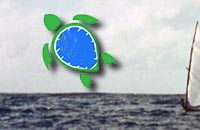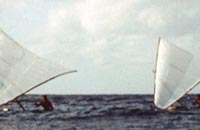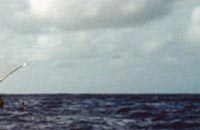|
|
|
Introduction April 30, 2013The settling of the remote Hawaiian Islands over 1,000 years ago is one of the great feats of human adventure. Ancestors of today’s Hawaiians crossed thousands of miles of open ocean to find and settle tiny dots of land in the middle of a sea that covers a third of the planet. In double-hulled canoes, they navigated back and forth across long distances using sophisticated knowledge of the sea and the stars. This story has captivated me since I arrived in the Hawaiian Islands in 1984 to attend graduate school. Only eight years earlier, the replica voyaging canoe Hōkūle‘a had been built and successfully sailed from Hawai‘i to Tahiti, some 3,000 miles to the south, using traditional navigation. The navigator was Pius Mau Piailug from the Micronesian island of Satawal, one of the few places where such knowledge still endures. This momentous event and its impact on the Hawaiian community have been wonderfully documented in Na‘alehu Anthony’s film Papa Mau. When I arrived in 1984, the excitement was still fresh. The Hōkūle‘a had taken on new challenges, and the revival of Pacific Island voyaging was underway. Now, three decades later, I’m working on an exhibition that focuses on the canoe both as a central object of Hawaiian culture and as a metaphor for how to live on this finite Earth. As part of the research for that project, I've interviewed a handful of contemporary Hawaiian canoe builders and about a dozen people involved with the Hōkūle‘a and other voyaging canoes, including the late Herb Kane, a founder of the Polynesian Voyaging Society. To comprehend the enormous task of building a voyaging canoe, I've interviewed stone toolmakers, including adze makers, cordage and fiber experts, botanists, wood carvers, and others. It would take an entire village perhaps a year to build and outfit a large voyaging canoe back in the old days. Since there was no usable metal on most Pacific islands, it is often said that this was “Stone Age technology,” but that belies the incredible sophistication involved. Well, talking to experts is one thing, but doing is another. In order to cement my expertise for this exhibition, and transform rote knowledge into actual experience, I’ve undertaken to build my own canoe. I’m a reasonably handy person but not a trained carpenter, so if I can do it, then anyone who can read directions and manage some tools can do it, too. I’d like to take you on my journey of building this canoe, and along the way, share with you some of the knowledge I’ve learned regarding traditional Hawaiian canoe building and all its related arts.
The Melanesia canoe will be 16 feet long—the same length as an ordinary American-style canoe. It weighs at most 110 pounds and is easy to lift. Almost the entire thing is made from two sheets of quarter-inch plywood. That’s right: I’m not cutting down a tree and carving it out. I’m also using other modern materials and modern tools, but as I go, I want to talk about traditional tools and techniques. The Melanesia uses what’s called the stitch-and-glue technique, which Wharram himself credits to Pacific Islanders. So, come with me on this voyage, and let’s see if we can build a canoe. —RDK Herman Next: Part 2: Harvesting a canoe log…or plywood
|
|||||

|
|||||
Copyright 2016, Pacific Worlds & Associates |





